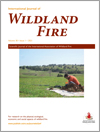International Journal of Wildland Fire
Volume 30
Number 1 2021
The public health emergency associated with the 2019–20 bushfires in Australia was a wake-up call to increase the resilience of our health systems to respond to climate extremes. We must combine our understanding of predictions of extreme weather events with our knowledge on emergency preparedness and response to protect the health of citizens.
Do elections matter for wildfires? I address this question by examining wildfire occurrence and burned area in Greek municipalities around the time of local elections. I find some evidence that elections and local politicians’ incentives can influence wildfire occurrence around the time of elections.
We evaluated the cost-effectiveness of applying mid-resolution satellite imagery to assess wildfire mitigation and restoration options in the western USA. The retrospective economic analysis demonstrated that using Landsat imagery instead of commercial satellite imagery can lead to considerable cost savings and helicopter reconnaissance in a Burn Area Emergency Response assessment of wildfires on public land.
Preparedness level designations support decisions about wildfire risk management, including pre-positioning of resources, recall of personnel from off-duty, requests for back-up, and decisions about fuel treatment and prescribed burns. We assess the association between preparedness levels and meteorology, active suppression resource levels and wildfire activity to explore preparedness level forecasting as a tool to inform wildfire risk management.
Fuel accumulation models have been used widely in wildfire management. Early approaches to analytical or continuous models of fuel accumulation centered around the model introduced by Olson in 1963. Motivated by the differences in the implementation of Olson model, we proposed a more general approach featuring vegetation density modelling.
We measured soil moisture, fuel moisture and curing in grasslands during two growing seasons in Oklahoma, USA. Fuel moisture and curing rate were largely dependent on soil moisture, with mixed-fuel moisture values <30% and high curing rates occurring only when soil moisture indicated severe or extreme drought conditions.





